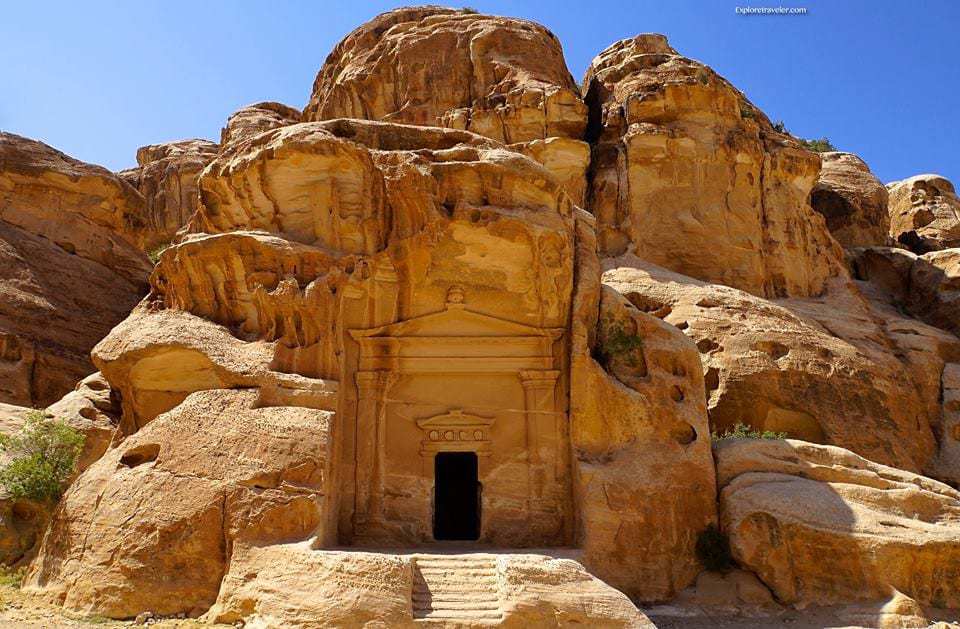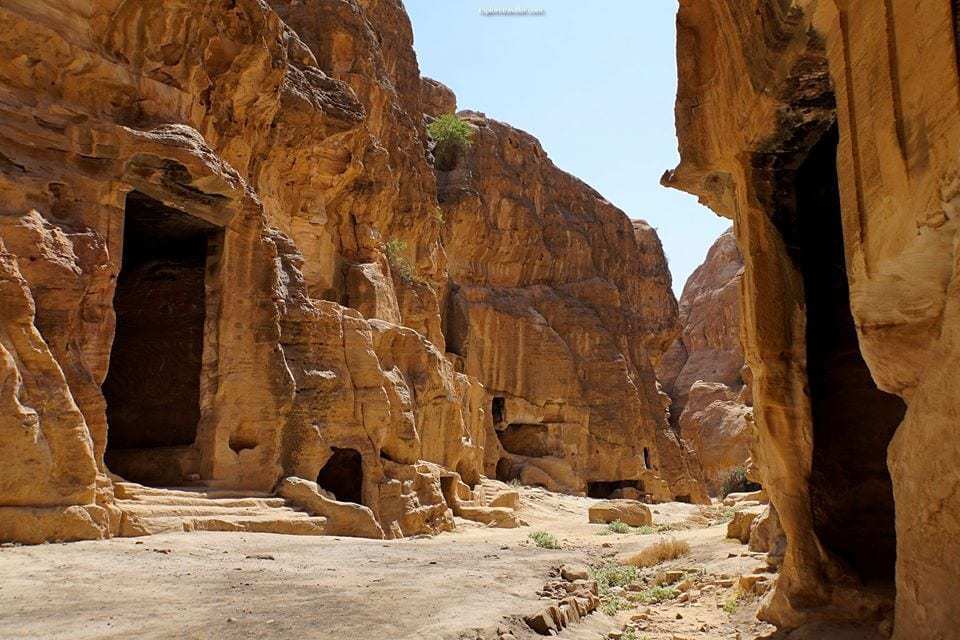Walking The Ancient Jordanian Paths
Walking the ancient Jordanian paths takes us back into the time of the Nabataeans. We begin our journey in the Siq Al-Barid. Leaving the hot open desert of Jordan behind we enter what is often called the “cold canyon.” The difference is noticeable as you step inside this deep cleft in the rock. Hidden from the eyes of a hostile and foreign world, the entrance to the Siq Al-Barid is just north of Wadi Musa. This narrow canyon is a step into the security system of an Ancient people. Traders traveling the Silk Road and others friendly to the Nabataeans had nothing to fear. This was a refreshing deep canyon that nature help carve into the mountainside. It was an incredible path through the mountain. It was secure from any enemies. It was magnificent! It was an oasis in the desert.
As we continue walking the ancient Jordanian paths we come face to face with an ancient culture. The culture and architectural skills of the Nabataeans was advanced beyond what would seem possible. This was an ancient people who knew the value of security and obscurity. They had a building skill that surpassed other civilizations of the First Century CE. This was a pathway through the rocky mountainside that lead to a carved city. It was the entrance into what is known today as Little Petra.
Siq Al-Barid is a canyon of 1,480 feet. Is it any wonder it is called the “cold canyon?” Here in this deep cleft of the rock, no sun could reach. It was a shady area, dimly lit, though a part of a sunny and hot desert. It must have been a reprieve from the scorching hot deserts that the Silk Road traveled through. This hidden narrow canyon provided both security and climate control.
As you walk through the Siq Al-Barid you will encounter cave after cave. Small caves and enormous ones flock the sides of the canyon walls. Some were simple and others more elaborate. These were most likely temporary quarters for the traders who had traveled from afar. A beautiful Inn for the weary traveler. Here in the suburbs of Petra, supplies could be restocked, camels were cared for, and the traders could find the rest they needed to continue on their journey. This was a Nabataean Inn on the way! Today, this area is the site of several archaeological digs. Relics and treasures of a past time tell the story of a way of life. It is the story of an ancient people with quality engineering skills. Skills that builders of today find interesting.
As you travel further into the Siq Al-Barid you will begin to see monuments. These monuments range from the very simple to the more elaborate. It becomes obvious to the traveler that many were constructed for the Nabataean Royalty. With their ornate statues and special shelves for the dead, it is evident that these were intended for prominent citizens of the kingdom. These monuments were more than just a place to bury the dead, they were a place to honor those who had passed. 
There are also many smaller monuments. These monumental caves were much simpler in design and usually lacked the doors and special shelves. A simple place to lay those who had left this world.They provided a place of dignity and honor for the deceased.
During the time that these hidden cities and siqs were constructed, the Nabataeans were a prominent people. They were powerful, and influential. The Nabataeans had a very complex character. They were ambitious and industrious. These were skilled Arab craftsman! During the early times of the Persian Empire, they were a nomadic people. They existed in the area of Petra, pitching their tents and moving to find fresh pasture and water for their herds. Out of this nomadic lifestyle arose a superior civilization. They were a people of two worlds. They were very Arabian and very Hellenized. They built with columns and other Westernized architectural designs. These designs were out-of-place in the Arabian Desert. This was an area that was inhabited by Bedouins and simple farmers. Still today, in this area you see the Bedouin tents that move as the need for fresh pasture and water arises. In this nomadic society, the Nabataeans carved a majestic civilization out of the sides of the sandstone mountains.
About the time that the Nabataeans began their building spree in the desert, they had just started getting involved with trading frankincense and myrrh. This was a very lucrative business in the area of South Arabia. This was the trade of the Queen of Sheba. Many centuries earlier this wealthy Queen paid a visit to King Solomon. We can read in history about her visit to the king, and her standard of living. Frankincense and myrrh are to this day some of the most valuable resources you can have.
Frankincense and myrrh are medicinal and fragrant plants. Their resins were valuable then and are still valuable today. These wildcrafted natural resources are found throughout the South Arabian Desert. They are then sold in the open markets throughout the Middle East. 
What are these natural resins and why are they so costly? Let us discover the wealth behind these cities as we continue walking the ancient Jordanian paths.
The resin of Myrrh is considered one of the most valuable and effective oils and tincture you can make for oral care. Throughout the Middle East and beyond a simple mouthwash is made of 1 part myrrh and 3 parts alcohol. It is used in the Middle East for loose teeth, infected and inflamed gums, and sore throats. It is also used for gingivitis, bad breath, mouth sores, and toothache. Freshly ground myrrh is available from many sources on the web, including the Apothecary’s Garden out of Canada. Following is a recipe for making a Tincture of Myrrh and how to use it. It was taken from the recipes of Apothecary’s Garden.
“A Recipe for a Tincture of Myrrh
- 1 part finely ground myrrh.
- 3 parts 45% grain alcohol or unflavored Vodka. A mason jar with a tight-fitting lid.
- mix the powdered Myrrh and the alcohol in the mason jar. Make sure to break up any lumps.
- Screw the lid on tight, (moisten your finger slightly with vegetable oil and run it around the thread on the outside of the glass before you screw the lid on tight. This will prevent the resins from “gluing” the lid closed if some of your tincture gets on the thread).
- Shake the mix thoroughly.
- Place the jar in a warm place out of direct sunlight. The top of a fridge, furnace or water heater work well.
- Shake your jar vigorously at least once a day for 4 weeks. Longer is fine too, but a lunar month should be sufficient.
- After your maceration is done, find a good spot to work.
- Filter your tincture into a clean jar or bottle that has a tight-fitting lid or cork. You can do this by pouring it through a paper coffee filter in a funnel (or a cheese cloth inside the funnel is what many use.)
- Scrape all the ground Myrrh into the filter. If you like you can try to press the rest of the liquid from the material, but be careful the paper doesn’t rip.
- Seal the jar or bottle and let your tincture sediment for a few days.
- pour or siphon off the clear liquid and bottle it for use. It can keep for a few years.
For sore, spongy or inflamed gums, loose teeth, Canker sores, toothache, Gingivitis, Halitosis, sore throat, or Thrush, mix 1 teaspoon of your tincture in a cup of warm water in which you have dissolved 1/4-1/2 teaspoon sea salt. Swoosh some around in your mouth for as long as you can, (spit it out when done), and as often as you can till you find relief. Use it a few more times, then continue using this tincture as a daily preventative.”
Frankincense has not had as much Western research to date as myrrh. All species of Frankincense are known in the Middle East to be anti-inflammatory. It is also used as an anti-aging cream, and is known to be helpful in rebuilding damaged nerves. According to Middle Eastern wisdom, there is a connection between the brain and the nerves when you rub it on a nerve damaged area. It is a hot oil and must always be diluted with a carrier oil. When using it as a Tincture, you can use the same recipe as above for Frankincense. Use a 1:5 ratio and substitute frankincense for myrrh. Many are finding that arthritis, inflamed joints and muscles, head trauma, and depression are all responding to frankincense.
Essential oils and resins are safe to use as long as you dilute them properly. However, they are considered medicines. There has not been any known side effects recorded as of yet. As with any natural herb or oil, it is only wise to talk to your own Alternative Care Physician before using.
As the cities in the desert were being built, the Nabataeans were gaining much wealth from the Indian Spice Trade as a whole. As their political and economic fortunes improved, so did their fast hold of lands. This continued till they controlled all the land from Damascus in the north to Hegra in the south. This was literally all the lands boarding the Arabian frontier. As the Nabataeans became more wealthy and prominent, they had to present themselves as equal partners in the International Community. They began to adopt the styles of the Hellenistic Civilization. Petra, Little Petra, and all the other smaller cities and siqs were built by kings looking forward to the future. It was a Greco-Roman future and they built their magnificent cities accordingly.
Even though you can see many Hellenistic influences, you also see a distinct Arabian side as you continue walking the ancient Jordanian paths. Especially in the caves and monuments you see a simplicity and minimalist style to their building. As you enter their cities and villages you see many simple high places. Many have stairs leading up to high places that almost seem to touch the sky. These are often little more than flat areas for their use. If you want to look out over the desert, climb the high places. They are simple and beautiful. They present an awesome view of the surrounding desert.
You will also find many of their rectangular stone blocks or betyls. These are found throughout the passageways and are unadorned. These unadorned blocks are thought to represent their many deities or gods. Again, this is Arabic simplicity. It is simple! It is minimalist. It is straight forward.
The last notable major accomplishment found in the canyon and byways is their water system. Like all civilizations, they had to find a way to harness water. You can see the broken cistern as you walk into Little Petra. That gives you a better idea of their enormous size. As you enter the city, you will see that every underground spring was used. They took advantage of many winter time downpour areas. They built aqueducts and channelled this water across flat areas. Every resource was used and taken advantage of. Walking through the siq, you will see the remains of their pipes for carrying water. Water flowed everywhere. There was water in the temples. They had water for their gardens. They even had water in their homes. This was a complex system. It was the finest water system of their time.
Another side to the water system was their dams. As you walk these ancient paths, you will see their retaining walls that kept flood waters out of their cities. Deserts are known for flash floods. They built walls to control the unwanted water.
By the Second Century this powerful civilization had become a part of the Roman Empire. While their cities flourished for a while, they soon also withered and died. They were empty. They became lost to mankind. Only the Bedouins knew and used them. In 363 AD the area was destroyed by an earthquake. It was not until the 20th Century that excavation of the area began. Many relics have been found. Amazing things are still being found. This is an area where the story is still being written. It is fascinating! It is living history.
There are few places on earth with as much living history as Jordan. If you want to walk the ancient paths, then make Jordan your next adventure. Walk through the Siq Al-Barid. Take time to climb the high places. Explore the caves. Discover the Cities. Have tea in the desert! It’s all waiting in Jordan.
There is also an authorized post on seemit under @exploretraveler at: https://steemit.com/@exploretraveler


